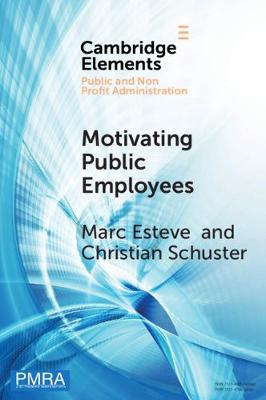Elements in Public and Nonprofit Administration
2 total works
What motivates public employees to work hard? This Element systematically reviews answers from public administration research. The authors locate this research in a novel two-dimensional typology, which shows that public employees can be motivated for other- and self-interested reasons and extrinsic (motivated by outcomes) and intrinsic (motivated by work itself) reasons. Public administration research sheds significant light on extrinsic motivators: working hard to help society (public service motivation), one's organization (organizational commitment) and oneself (financial incentives). Future research should focus on hitherto understudied motivators: symbolic rewards and intrinsic motivators, such as enjoyable work tasks, warm glow, and relatedness with colleagues. Supplementary material for this Element is available online.
Management and Governance of Intergovernmental Organizations
by Ryan Federo, Angel Saz-Carranza, and Marc Esteve
Published 3 December 2020
What happens to intergovernmental organizations (IGOs) after their creation has remained in mystery over the years. Although the current globalized outlook has sparked new and growing interests on the role that IGOs play in the global landscape, the scholarship has largely focused on the political aspects of cooperation, primarily on how and why different IGO member states interact with each other and the outcomes associated with such cooperation. Research is yet to untangle how these organizations work and operate. This Element addresses this niche in the literature by delving into two important aspects: the management and governance of IGOs. We build on a four-year research program where we have collected three types of different data and produced several papers. Ultimately, the Element seeks to provide scholars with a description of the inner workings of IGOs, while providing guidance to policymakers on how to manage and govern them.

